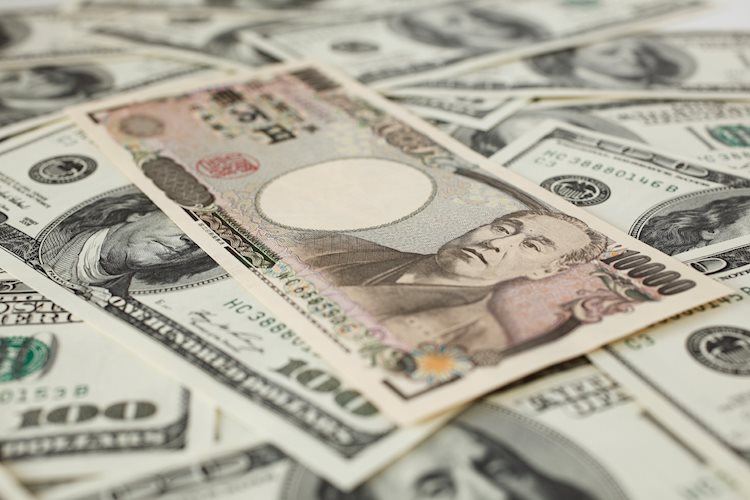- The Japanese Yen remains on the defensive against the buck amid the BoJ rate hike uncertainty.
- The USD stands tall near a two-month top amid bets for a less aggressive policy easing by the Fed.
- The divergent BoJ-Fed policy expectations might cap any meaningful upside for the USD/JPY pair.
The Japanese Yen (JPY) struggles to register any meaningful recovery against its American counterpart and hangs near its lowest level since early August through the Asian session on Monday. Japanese Prime Minister Shigeru Ishiba’s remarks earlier this month, saying that the economy was not ready for further interest rate hikes, raised doubt about the Bank of Japan’s (BoJ) rate hike plans. This, along with a generally positive tone around the equity markets, continues to undermine demand for the safe-haven JPY.
The US Dollar (USD), on the other hand, remains firm near a two-month high amid growing acceptance of a less aggressive policy easing by the Federal Reserve (Fed) and turns out to be another factor acting as a tailwind for the USD/JPY pair. The Fed, however, is still expected to lower borrowing costs by 25 basis points in November. In contrast, the BoJ is more likely to stick to its rate-hiking cycle. This might cap the upside for the currency pair amid relatively thin trading volumes on the back of a partial holiday in the US.
Daily Digest Market Movers: Japanese Yen bulls remain on the sidelines amid doubts over BoJ rate hike plans
- The futures market implies a less than 50% chance that the Bank of Japan will hike interest rates by 10 basis points before the end of this year in the wake of Japanese Prime Minister Shigeru Ishiba’s dovish turn earlier this October.
- Moreover, a drop in Japan’s real wages for the first time in three months, declining household spending and signs that price pressures from raw material costs were subsiding cast doubts over how aggressively the BoJ could raise rates.
- China’s finance ministry hinted at more debt issuance amid efforts to shore up the domestic economy and said that the central government has room for a deficit increase, though fell short of providing specific details of the stimulus.
- Investors, however, seem optimistic that comprehensive measures will be introduced to stabilize key sectors of the economy and further took cues from the recent rally in the US equity indices, which touched record highs on Friday.
- The US Bureau of Labor Statistics reported that the headline Producer Price Index (PPI) for final demand rose 1.8% and the core gauge climbed 2.8% on a yearly basis in September, both coming in slightly above market expectations.
- This comes on top of last Thursday’s hotter-than-expected US consumer inflation figures and closes the door for another jumbo rate cut by the Federal Reserve in November, pushing the US Dollar back closer to a two-month top.
- That said, the US central bank is still expected to continue lowering interest rates amid signs of labor market weakness and the BoJ is anticipated to hike rates again by the year-end, which caps the upside for the USD/JPY pair.
Technical Outlook: USD/JPY setup supports prospects for additional gains towards 150.00 psychological mark
From a technical perspective, the recent breakout through the 50-day Simple Moving Average (SMA) barrier – for the first time since mid-July – and acceptance above the 38.2% Fibonacci retracement level of the July-September downfall favors bulls. This, along with positive oscillators on the daily chart, suggests that the path of least resistance for the USD/JPY pair remains to the upside. Some follow-through buying beyond last week’s swing high, around the 149.55-149.60 region, will reaffirm the positive bias and lift spot prices to the 150.00 psychological mark. The momentum could extend further towards the 50% Fibo. level, around the 150.75-150.80 region.
On the flip side, any meaningful slide below the 149.00 round figure could be seen as a buying opportunity near the 148.55 region. This should help limit the downside for the USD/JPY pair near the 148.00 mark. The latter is likely to act as a key pivotal point, which if broken decisively might prompt some technical selling and drag spot prices to the 147.35 intermediate support en route to the 147.00 mark and the 146.50 area.
Bank of Japan FAQs
The Bank of Japan (BoJ) is the Japanese central bank, which sets monetary policy in the country. Its mandate is to issue banknotes and carry out currency and monetary control to ensure price stability, which means an inflation target of around 2%.
The Bank of Japan embarked in an ultra-loose monetary policy in 2013 in order to stimulate the economy and fuel inflation amid a low-inflationary environment. The bank’s policy is based on Quantitative and Qualitative Easing (QQE), or printing notes to buy assets such as government or corporate bonds to provide liquidity. In 2016, the bank doubled down on its strategy and further loosened policy by first introducing negative interest rates and then directly controlling the yield of its 10-year government bonds. In March 2024, the BoJ lifted interest rates, effectively retreating from the ultra-loose monetary policy stance.
The Bank’s massive stimulus caused the Yen to depreciate against its main currency peers. This process exacerbated in 2022 and 2023 due to an increasing policy divergence between the Bank of Japan and other main central banks, which opted to increase interest rates sharply to fight decades-high levels of inflation. The BoJ’s policy led to a widening differential with other currencies, dragging down the value of the Yen. This trend partly reversed in 2024, when the BoJ decided to abandon its ultra-loose policy stance.
A weaker Yen and the spike in global energy prices led to an increase in Japanese inflation, which exceeded the BoJ’s 2% target. The prospect of rising salaries in the country – a key element fuelling inflation – also contributed to the move.

